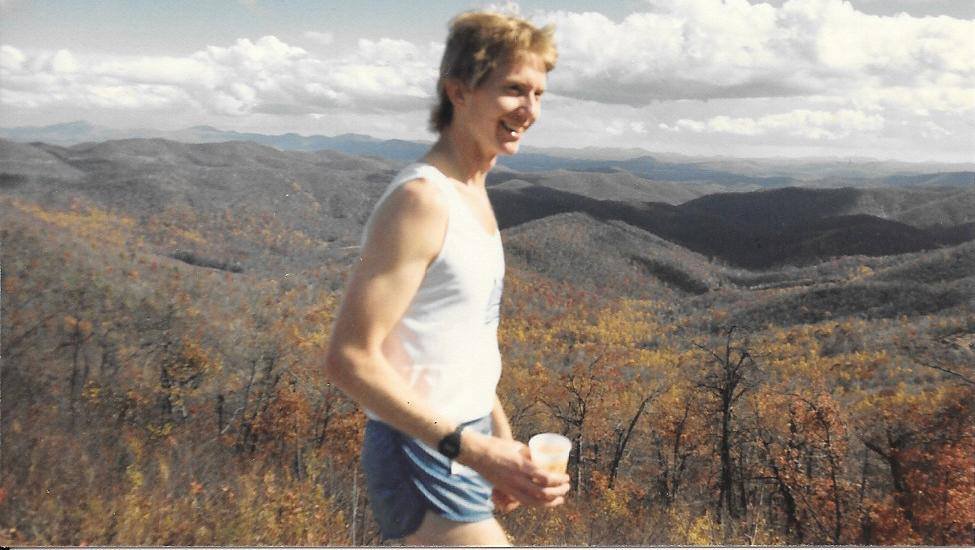Issue #2: Supplements!
The Asheville Running Collective is here for a second edition of the Shut-In Training Program newsletter to provide you with a proverbial medicine cabinet chock full of powerful supplements to boost your training. If you missed the the rollout of the program, you can check it out on our website where we will archive all of these posts.
OK, here’s the plan: take a teaspoon of ACV (apple cider vinegar, duh!), with a 1/2 gallon of EVOO (healthy fats!), 2 packets of expired GUs that have been heating up in your car all summer (save the safer room temp ones for race day), a handful of that green probiotic powder you bought on the recommendation of a podcaster, and a smashed up assortment of whatever you can find in those half-empty bottles of Runner’s Daily Multivitamins stuffed in the back of your closet. Now, fire up your Magic Bullet and…
Of course, that was a joke, and a gross one to boot. In reality, we’ve got a healthy serving of training ideas, strength exercises (from an actual expert!), and interesting resources to supplement the plan you’ve already got in place. Let’s dive in.
Work on Your Weaknesses (Now)
With a bit less than two months until race day, it’s a great time to assess your skills and abilities as they relate to the specific demands of the Shut-In race course. How’s your efficiency when climbing? Are you quick and nimble down the backside of Ferrin Knob or are your heels digging holes in the trail as you grab for the nearest tree at every switchback? What gives out first: your lungs or your legs?
As mentioned in the first edition of this training program, this is an aerobic event. High-end sprint speed is certainly helpful to grab prime camera time up front in the first 100m, but as you are crossing 151 with a couple miles and several hundred feet of gain still to come, you’ll probably be drawing on the strength of the long runs you’ve put in over the course of your training block (or cursing the ones you missed). So, aerobic conditioning, base building, endurance work, or whatever you want to call lots of time spent on your feet still needs to be the priority.
Beyond that, you should consider how to fill in the gaps in your fitness and/or skills. These supplementary sessions should be moderate efforts that don’t require you to significantly alter the rest of your week’s plan. Think of it like “skill building” rather than “fitness building”.
Here are a few different categories and session ideas, based on generalized runner types:
Runner A: I can go up all day, but I fall behind on the flats and downs.
Consider adding in supplementary workouts to improve efficiency and turnover. Short, fast sessions at the track, short hills at a quick effort, and pace-changing workouts on the trail could go a long way in this regard. Some ideas:
Strides: There’s really no bad time to throw in 4-6 x 20-sec quick (40-sec jog). Mix it up with some pick-ups in the middle of a run OR finish off a trail run with some quick & smooth parking lot bursts.
Hills + 200s: 4-6 x 40-sec hill reps at quick (but controlled) effort + 4-6 x 200m at the same effort (of course you can just do 40-sec on any flat terrain if you don’t have access to a track).
Up and Overs: Add a flat or downhill portion to your previously planned hill reps. Practice keeping your rhythm as you crest the hill and seamlessly transitioning to 10-20 seconds of additional running on a subsequent flat or downhill stretch.
“True” Fartlek: Over the course of 20-30 minutes, throw in pickups of 30-seconds to 2 minutes with easy running between. Don’t overthink it. Don’t try to structure the perfect session. Just run from this tree to that tree pretty quick, jog for a bit, and repeat a bunch of times.
Runner B: My legs give out before my lungs.
You may need to improve your race specific muscular endurance. This can happen in the weight room, but it’s getting late in the game to try too many new non-running routines. Instead, focus on the demands of the course that pose the biggest challenge for you. One guess: hills.
Steep Power Hiking: Find the steepest hill you can and power hike up several times. Keep volume moderate to begin, so try 4 x 5:00 the first time, and build over 2-3 subsequent sessions.
Long Uphill Grind: Find a the steepest grade that you can run and lock into your efficient climbing gear for 10-20 minutes. The treadmill works for this, too.
“Hit the Hills” Fartlek: Run this like the “true” fartlek above, but all pickups occur on the uphills. Flats and downs are run nice and easy.
Runner C: I move well on the flats, ups, and downs, but I run out of steam as the time goes on.
You need to focus on building your aerobic engine. Keep maintenance workouts in for climbing, efficiency, etc, but add in another endurance-focused session.
Medium Long Run: this can be somewhere in the zone of 75% of the duration of your current long run. Keep the effort easy.
Steady Run: Elevate your “easy run” pace slightly. Use the “talk test” to go from chatting in full paragraphs to speaking in one or two sentences at a time. You are still in control and should be able to hold this effort for a long time. Start with 30 minutes in the middle of a run and build toward 60 minutes over the course of the cycle. This effort could be considered “aerobic threshold”, the top of zone 2 on a 5-zone HR model, or “steady state” depending on who you ask.
As a reminder, these sessions should all supplement the major workouts and long runs you are all planning. Beware of the temptation to turn everything into a “fitness building” workout. If you push these too hard, you run the risk of compromising a higher priority training day later in the week.
- Mark
Make #Gains
Many of us in the WNC running community know Miriam Salloum as one of the three emergency contacts in our phones. Thankfully, she hasn’t figured out how to block our calls, and she actually keeps her cool when we text asking for an appointment in the next 20 minutes.
Miriam is the the talented physical therapist behind The Runners Mechanic located in downtown Asheville. Below you will find a series of exercises well suited to athletes taking on the demanding ups and downs of Shut-In. Use these as activation work prior to a run OR as part of a separate strength session.
Check out the whole playlist of Miriam’s videos here:
The Best Strength Exercises for Power and Symmetry with Running
In Their Own Words
One of the goals of this Shut-In project is to document the history of the event. Along with race stats, course changes, and interesting results, we plan to share race recollections and advice from a variety of runners.
This week, Javan Lapp got on the phone with 34-time Shut-In Ridge Race finisher Chris Campbell to talk about his long relationship with this special section of trail. Chris has a best finish of second place from the 1990 edition of the event.
This interview was edited for length and clarity.
Javan Lapp: Are there any secrets to your longevity or anything you’d attribute to your success over such a long time period?
Chris Campbell: Well, mostly dumb luck, I guess.
When I turned 40, I was going to try to run some races and try to set some masters course records. I immediately got injured. That didn't work out so well! It took a year or so to figure out what I could do as I got older. I think I've just done a pretty good job since then to monitor when I'm doing too much or when something doesn't feel right. I learned to back off, whereas my younger self would have just said “you can run through that”. And, as you will see, at some point, usually you can't.
JL: I'm already learning that lesson.
CC: Definitely. I’ve actually gone through the whole spectrum of finishes. From being top-20 a bunch of times to 2019 when I turned my ankle in training and really didn’t know if I would be able to make the cut offs. That ended up being my slowest year, but in a lot of ways it was really satisfying. Knowing the course helped me a lot that year, and knowing that I just had to plug away at it and not do too much too early.
JL: What are the differences in the experience of racing toward the front versus the middle or the back of the pack?
CC: They're really different. Most years now, I just try to get out and enjoy the trail. Certainly, you know, I want to run it as fast as I can on that day, but not at the expense of making myself miserable. My days of being out front are done, so I might as well get out there and enjoy the heck out of it.
I've had a couple of years in the last ten or so where I just kind of hooked up with somebody who was either a first time racer or a less experienced Shut-In runner. I’ve gotten into some conversations and gotten to know people in the middle of the pack, which was kind of cool.
1991...First time Shut-In is shortened due to snow.
JL: Any guiding advice for new Shut-In racers?
CC: The first thing I would tell them is basically treat it like training for a marathon. However, focus more on time than distance. When doing a road marathon most people work the long run up to 20 or 22 miles. Use the time it would take to run that far on the road to plan what you want your longest run to be on the trails.
Also, I've noticed that a lot of the mid pack runners or those from an ultra background walk many of the hills from the outset. You can't do that at Shut-In if you're going to make the cut off times. So somebody who's coming from an ultra background or someone trying to make the cut offs, they definitely need to have more of a mindset that they've got to run up hills that are not super steep.
JL: Has Shut-In always been the main trail race you’ve focused on?
It just became my fall marathon. I never really set out to to run it as much as I have. But I just haven't found a good reason not to run it.
Chris in 1988
Thanks to Chris for sharing his wisdom, as well as these great photos!
Up Next
The details of Phase 2 and the Taper Phase will be introduced and explained in the coming weeks.
Future missives will also cover:
- Suggestions for planning your training volume
- More workout ideas!
- Tips, tricks, and race recollections from experienced Shut-In racers
What would you like to read more about? Send us your questions, comments, or ideas with “SHUT IN” as the subject line.







